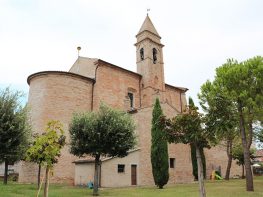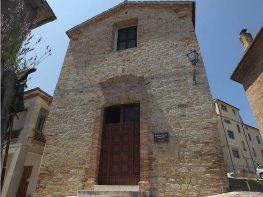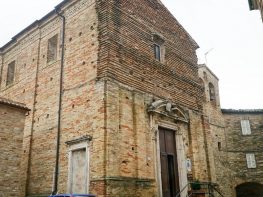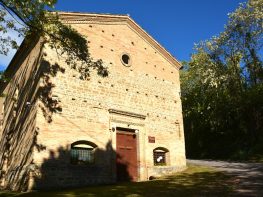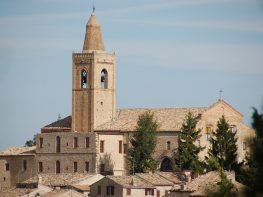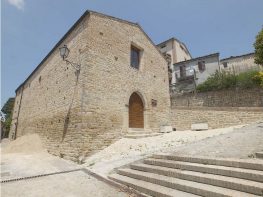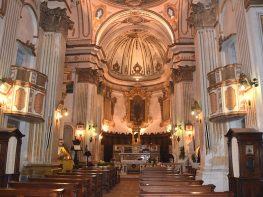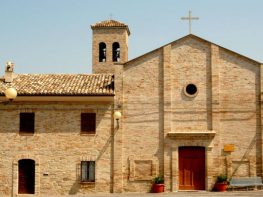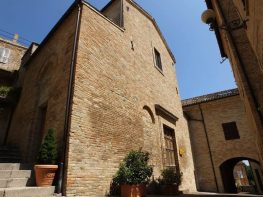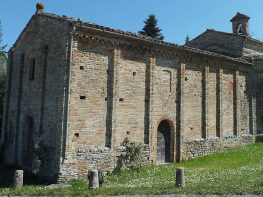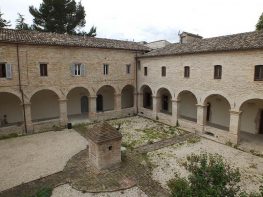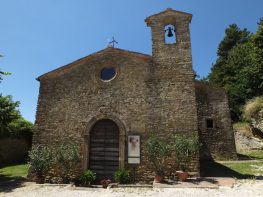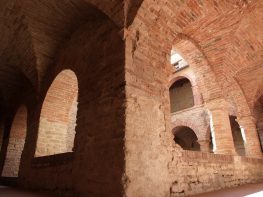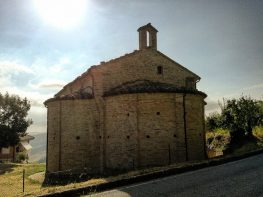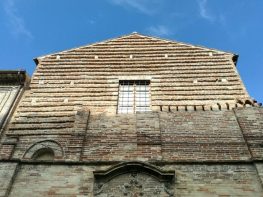L’esistenza della Chiesa del SS. Salvatore è testimoniata nei documenti dei monaci farfensi sin dall’anno 1180. Qui passava l’antica strada collinare fermana e, anche grazie alla costruzione della nuova chiesa, si ampliò ulteriormente il centro storico del nuovo castello di Belmonte Piceno.
L’attuale chiesa è stata ricostruita dal 1771 al 1776, per decisione dell’arcivescovo fermano cardinale Urbano Paracciani, su disegno architettonico di Domenico Fontana, con l’opera del maestro urbanista Pietro Augustoni.
La facciata, in mattoni dal caldo colore roseo, è ornata con pilastri laterali e lesene dai capitelli dorici. Il frontone triangolare, nel fastigio, ha cornici mistilinee ed è sormontato dal simbolo cristiano della croce.
Il portale, con sua cornice, ha un sovrapporto ad arco con lunetta. Il portone è in triplice strato di tavole ed è scandito in sedici specchi con cornici.
Troviamo, all’interno, pregevoli quadri ed affreschi di diversi autori, fra i quali spiccano Filippo Ricci, Armando Moreschini e Giuseppe Toscani. Interessante, sulla parete del presbiterio, il gruppo scultoreo della Pietà, con la Madre che tiene tra le braccia Gesù morto, opera in legno riferibile al XV secolo circa.
Di grande valore storico‐artistico è la Santa Croce di Gesù Messia, conservata in un prezioso reliquiario d’argento, cesellato e dorato, che viene portato in processione, annualmente, nella festa patronale del 3 maggio.
Da segnalare è l’organo nel retrofacciata, opera dei valenti organari Paci, di Ascoli Piceno, anno 1882.
Svetta, sopra la chiesa, adiacente al palazzo comunale, la torre campanaria, ampliata alla fine del XVIII secolo e dotata successivamente di orologio alla francese.
The existence of the Church of the SS. (Santissimo or “Most Holy”) Salvatore dates back to 1180; reference to it can be found in documents of that year written by Farfense monks. Here the ancient Fermano hill road passed by, and due to the construction of the new church, the old centre spread further around the castle of Belmonte Piceno.
The actual church was rebuilt between 1771 and 1776, following the decision taken by the Fermano archbishop Cardinal Urbano Paracciani, and was based on the architectural design of Domenico Fontana, with the assistance of the master town planner Pietro Augustoni.
The warm pink brick façade is ornate, with side pilasters and pillars with doric capitals. The triangular pediment, at its apex, has mixed linear cornices and on the top the Christian symbol of the cross can be seen.
The corniced main entrance has an arched doorframe with a lunette. The main door has three layers of panels and is divided into sixteen framed mirrors.
Inside, we can find exquisite paintings and frescoes by various different artists, including Filippo Ricci, Armando Moreschini and Giuseppe Toscani. On the presbytery wall, the set of wooden sculptures named “Pietà” is of great interest: created around the 15th century, the Holy Mother is portrayed holding the deceased Jesus.
The Blessed Cross of Jesus the Messiah is of great historical and artistic value, preserved in a precious engraved and gilded silver reliquary. It is taken on the annual procession to mark the saint’s day on 3rd May.
Also of note is the organ on the counter-façade, the work of talented organ makers Paci of Ascoli Piceno, in 1882.
Standing out above the church, adjacent to the Town Hall, is the bell tower, which was extended at the end of the 18th century and was given a French clock.





















